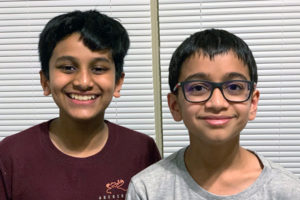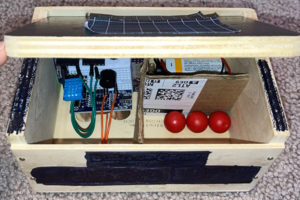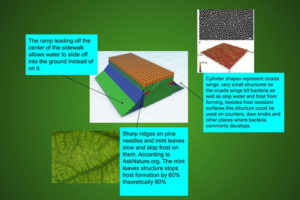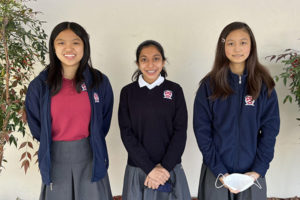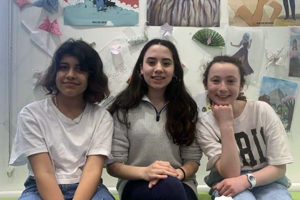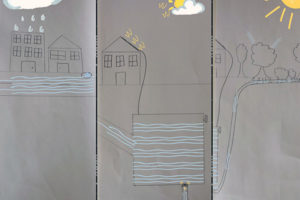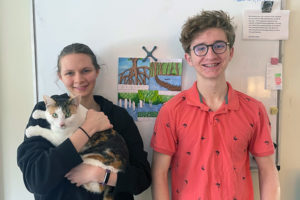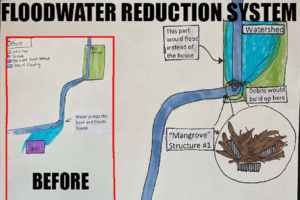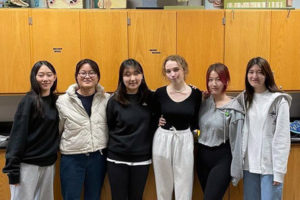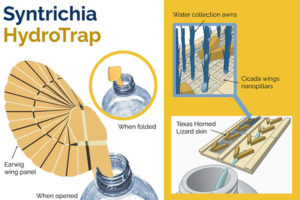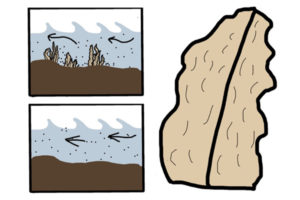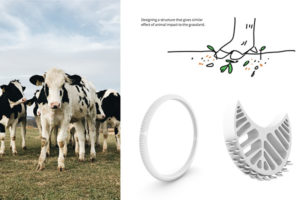Meet the Newest Young Innovators in Biomimicry
This year, the Biomimicry Institute’s Youth Design Challenge supported thousands of middle and high school students to look to nature to solve local design challenges.
May 3, 2022 — From urban flooding and stormwater management to increasing access to clean drinking water in drought-prone areas, the Biomimicry Institute’s 2021-22 Youth Design Challenge (YDC) winners have offered unique, nature-inspired ideas to solve local design challenges. The YDC, now in its fifth year, serves as a bridge from core concepts to advanced project-focused STEM learning for middle and high school students across the world.
The Youth Design Challenge is an open access experience that leads middle and high school educators and students through a project-based curriculum that immerses them in the practice of biomimicry—looking to nature for inspiration to solve design problems in a regenerative way. Students, along with teachers and coaches, engage in design-focused and project-based learning to solve a problem they’ve identified. Solutions are created through an iterative design process as students engage with nature from a new perspective.
“We are grateful to the teachers, students, and communities for showing us that they want to engage in these deep explorations of nature using the practice of biomimicry,” said Rosanna Ayers, Director of Youth Education at the Biomimicry Institute. “The projects submitted this year were exceptional for their uses of biomimetic design to creatively approach solutions to local problems affecting their communities.”
The YDC is a U.S.-based competition, but also supports international submissions. This year, the YDC received 125 submissions from 12 countries and addressed a wide array of Sustainable Development Goals (SDGs). The focus on SDGs was new to the 2021-22 program to both introduce students with the global goals, as well as empower them to choose which goal best resonated with them in attempting to solve a local design problem. Participants this year were also introduced to an updated approach to the MIMIC lesson plans, which offered a smoother transition from each step designed to better help educators incorporate biomimicry into their classrooms.
“There were a lot of brilliant ideas and a really tough choice to select the best,” said Nermina Lamadema, a judge from this year’s Challenge. “It was very inspiring and a joy to go through students’ portfolios and understand how they rationalized some very important SDG issues.”
The Biomimicry Institute is excited to announce this year’s Biomimicry Youth Design Challenge winners are…
MIDDLE SCHOOL
First Place: The Fire Forewarner
- Team
- Design Concept
In recent years, the problem of wildfires in California has increased as residents have witnessed thousands of wildfires and millions of acres burned. The Fire Forewarner, developed by Aaryan & Kovid’s Team, is a device that aims to help bring those numbers down. The design concept is a solar-powered box that contains a protected circuit board and flame retardant capsule with a high temperature glue on the lid. When the temperatures reach high enough to melt the glue on the lid, the box opens and immediately sends a signal to the nearest fire department warning them of the fire, and the capsules are used to contain the fire in the meantime. The Fire Forwarner includes inspirations from Banksia seed pods, which release seeds when the cones are heated to a certain temperature, and the Crossopteryx bark, which was used for insulation of the materials inside the box.
Second Place: Ice Resistant Surfaces
- Team
- Design Concept
In Montana and similar winter-stricken cold environments, planes need to be de-iced. Chemicals used in deicing are hazardous to the environment and eventually flow into rivers, lakes, and groundwater. These chemicals harm the ecosystems and contaminate the water supply. The BioSurfaces team aimed to reduce the need for harmful chemicals used and came up with the idea of Ice Resistant Surfaces. They looked to inspiration from mint leaf surfaces with their tall peaks and valleys with angles in-between to stop ice formation. Going even further, a bumpy surface design emulated from the hydrophobic Cicada wings helps prevent frost, as well as bacteria, from building up. The team also found inspiration from pine needles, which are thick and covered with a waxy substance called cutin. Their design incorporated all three to make the BioSurface model, which can stop frost from developing on surfaces and can work on various surfaces.
The design was recognized for its design principles demonstrating deep emulation from various organisms and their inventive prototyping and testing that offered a 3D printed model that scaled.
Third Place: CactiShirt
- Team
- Design Concept
Climate change is leading to rising temperatures; and in those places where heat is already at an uncomfortable point for humans, it can only get worse. Interrobang from San Jose came up with CactiShirt: a design to passively cool a person down with a shirt that incorporates microscopic folds, just like desert cacti, to increase the surface area to allow more heat to radiate. The CactiShirt is designed to also be lighter in color so that it won’t absorb as much heat as darker colors, just as chameleons can change to a lighter color when they get hot. The material for the CactiShirt would be euphorbias, which are plants that have a waxy surface that can help protect from heat.
The judges were impressed by the team’s iterative process of learning and how they put the project together. The design was locally attuned to address a problem affecting their community with a fashionable approach that can appeal to many people.
International Honorable Mention: The Floodulator
- Team
- Design Concept
London has a significant number of properties with occupied basements that can be problematic for the dwellers when a heavy rainfall or flash flood occurs. Taking on the local urban flooding issue, team Biomimicking Bosses Association in London, England looked to nature for their project. The Floodulator is a system that includes a locally designed pipe on the ground level to store the rainwater underground in a boxfish-shaped tank (for water control and rigidity) that can distribute water to other areas of the city. More specifically, it can help distribute excess water in areas of flooding where the drainage system has been overwhelmed to London’s greener areas. The tank would be made of material inspired by Arapaima fish scales, which consist of two layers, and be covered in a dense layer of hair similar to that of reindeer guard hairs. The long, water-repellent hairs will create an impermeable layer all around the tank.
The project was selected for the team’s thoughtful approach to solving a local problem that offered creativity, imagination, and a great example of learning from nature.
HIGH SCHOOL
First Place: Urban Floodwater Reduction System
- Team
- Design Concept
To take on a local urban flooding issue, team Garage School Scholars out of Edmonds, Washington looked to mangroves and beavers to help people in their community living near Shellabarger Creek. Their Urban Floodwater Reduction System slows down water by splitting up the flow and creating tortuous paths; creates blockages to flood-designated areas upstream; and negates the amount of energy the water carries as it flows downstream towards the house most affected by the creek’s flooding.
The design was awarded first place in the high school category because of its local scale with life-friendly materials integrated into the local community. The team offered a well-researched, tested, and prototyped project that aligned well with SDG 11 (Sustainable Cities and Communities) and demonstrated a thorough mimicry of the biological organisms chosen.
Second Place: Syntrichia HydroTrap
- Team
- Design Concept
With clean water becoming less accessible throughout the planet and bottled water consumption increasing plastic pollution, FA Biomimicry Challengers, a group of students from Maine, developed a water harvesting device to help. The Syntrichia Hydrotrap is portable, attaches to any reusable water bottle, and uses a unique structure to capture moisture in the air. By mimicking the awns of desert moss (Syntrichia caninervis), the design concept uses water pumps to collect water droplets through barbs and grooves. The water is channeled along a hydrophobic surface material inspired by textures used by the Texas horned lizard and Cicada wings. The Syntrichia HydroTrap can be used across climates, offering a solution to areas experiencing droughts and reusable alternatives to aid the plastic pollution problem.
The project exceeded expectations from the judging committee by providing a full system perspective for plastic pollution, clean water, responsible production, and going as far as considering cleanliness and antibacterial transfer properties.
Third Place: River Reef
- Team
- Design Concept
The local stormwater runoff issue in Johns Creek, Georgia inspired the Aquanauts to come up with the River Reef project as a way to mitigate the problem in their community. Stormwater runoff erodes the riverbanks, causing natural plants/trees to slowly submerge; and it drags sediment along its path causing several biodiversity issues. The River Reef is a cluster of banana leaf-like structures with a rough surface made of RPET, a bio-friendly plastic, that can be adjusted and placed at the bottom of any waterway. The design uses strategies inspired by seagrass and rough cactus coral to help slow down currents and trap sediments carried by the water.
The selection committee was particularly impressed by how the team interviewed the city council to better understand the community’s design problem and how they looked at the local problem of the riverbed degrading and eroding the foundation in their own backyard. The research that commenced included prototyping ideas directly into the community.
International Honorable Mention: Greenification
- Team
- Design Concept
Grass needs to decay biologically in order for new, healthy grass to grow. When it does not decay properly, desertification results. The solution is typically to burn fields to expedite the decaying process, however, that can cause excess carbon and methane to be released into the atmosphere. The Green Waves team from Anseong, Korea came up with an environmentally-friendly concept to solve this desertification problem. They created a land trampling structure to mimic the movement of herds in a grassland. Herd movement through the grasslands can be a healthy alternative to burning fields, because as the herd passes by, they redistribute nutrients across the field and break down the soil. The team’s solution also accounts for the balance needed here as overgrazing can also result in more desertification. The structure they conceived is flexible and sturdy, like banana leaves, and is lined on the surface with hundreds of hollow, rigid spines inspired by the tongue of a cat. Their design can be used to create any shape to add to agricultural tools and help with the process of revitalizing fresh, healthy grass.
The unique solution was recognized for the interconnectedness of plants’ and animals’ reliance on one another, and for the team’s respect and observation of a full ecosystem approach. The prototyping offered creative application ideas and was encouraged by the judging committee to continue exploration of the concept.
“I most of all loved reviewing these amazing students and the work they did,” said Dillon Behling, a judge from this year’s Challenge. “It was also a pleasure to work along with other biomimicry enthusiasts and experts.”
To learn more about the Youth Design Challenge, and how to get involved, visit biomimicry.org/youthdesignchallenge. For more information on the Biomimicry Institute’s Youth Education initiative and professional learning opportunities, visit biomimicry.org/education.
####
About the Biomimicry Institute
The Biomimicry Institute is a 501(c)(3) not-for-profit organization founded in 2006 that empowers people to seek nature-inspired solutions for a healthy planet. To advance the solution process, the Institute offers AskNature.org, a free online tool that contains strategies found in nature and examples of ways they are used in design. It also hosts a Biomimicry Global Design Challenge and Youth Design Challenge to support project-based education; a Biomimicry Launchpad startup accelerator program; a Ray of Hope Prize® for developing companies to bring designs to market; and a Biomimicry Global Network that connects innovators across the world.
Media Contact
Lex Amore, Director of Partnerships and Advocacy
[email protected]
415-800-1407
We will use the information to be in touch with you via email. You can change your mind at any time by clicking the unsubscribe link in the footer of any message you receive from us. Learn more about our privacy practices here.
Support the Next Generation
of Nature-Inspired Innovators
Imagine a world where everything we make is inspired by the natural world. By supporting the Biomimicry Institute you:
- Help bring biomimicry education to more students and educators
- Accelerate the growth of more nature-inspired startups and entrepreneurs
- Increase the number of biological strategies and resources on AskNature.org and across our entire organization.

